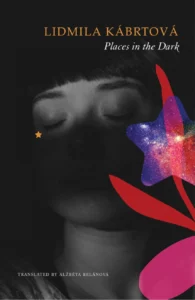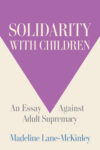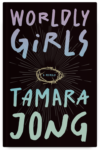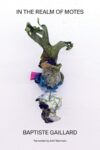
[Seagull Books; 2025]
Tr. from the Czech by Alžbeta Belánová
A book with a title like Places in the Dark announces its themes early. The original Czech cover of Lidmila Kábrtová’s second short story collection, translated from Czech to English by Alžběta Belánová, features a worm inside a rotting apple, conspicuously signaling that the characters at the core of these stories—all women, because it was Eve, after all, who bit the forbidden fruit first—are being consumed from within. Apples show up inside the pages—angrily hurled into the sky, kicked out of frustration in a garden, mindlessly tossed into a drawer—as overt symbols of a paradise lost. There’s little subtlety, but here’s the surprise: it works.
Kábrtová’s twelve stories in this collection—set in indeterminate times and places with only sporadic mentions of Prague and rendered in Belánová’s unobtrusive yet compelling English translation, as seen in her recent work on a Simona Bohatá short story—invite readers of all stripes into a world they could easily inhabit.
The stories are best read in order. The first half introduces the cast of characters who will cross paths throughout the book, each encountered at a turning point in her own life, while the rest traces the tangled threads of these women’s fates, almost a game of who’s-meeting-who-now. Little wonder, then, that Places in the Dark is described on the back cover as “echoing the brilliance of Alice Munro,” whose short story cycles probed the inner lives of girls and women. Unlike Munro’s worlds that often move fluidly back and forth through time in a single story, however, Kábrtová’s universe unfolds more straightforwardly, drilling to the core of that rotten apple in step with chronological time. Perhaps this slight departure from the Munro mold offers a reprieve. In her author’s notes, Kábrtová stresses that “the stories and characters in this book are fictional.” Her stories, executed in direct and penetrating prose, are untainted by the shadow that now looms over Munro’s literary legacy.
The book, which teems with seeds sown in girlhood that blossom into their wild, untamed splendor in womanhood, brought to mind another Nobel-winning Canadian author: Louise Glück. In her poem “Nostos,” which fittingly begins with “an apple tree in the yard,” Glück observes that “we look at the world once, in childhood. The rest is memory.” Using the first, second, and third person perspectives across the collection, Kábrtová seems to ask these central questions: Can we ever escape our early beginnings? Or do they ossify into nature, forever embedded in our being? And even if escape is possible, will we choose it?
In “Wild Woman,” forty-something Magdalena listens to a reading of an ex’s first book while nursing a long-held grudge: “Magdalena hated women with horse faces, since it was exactly one such beauty queen who stole her first boyfriend, and it didn’t matter that it happened in dance classes twenty years ago.” The object of Magdalena’s contempt is the moderator, Viola, whose voice “hinted at lessons in phonics and voice training, but now and then it still failed her, and there was a slight wobble, an inflection, a question mark ending a sentence that wasn’t a question.” As Magdalena watches this woman, who looks like “an ethereal enchantress,” she contemplates the seemingly preordained essence of her physicality:
Magdalena’s body, too, was slender and firm, but it never got rid of the heaviness typical for country women. Although many generations of her ancestors (the last three she knew for sure) had lived in the city and became public servants or teachers, the genetic code of the earthy peasants from which her family descended could not be denied. Her back arched more robustly than was customary for women, as if it was still bracing itself for the weight of a sack full of potatoes, her shoulders broad, her arms remained strong. Moreover, she walked with the swaying, heavy gait of peasants who place their feet on the ground wide, noisily, and instead of stepping on the entire flat of the foot, they step mainly on their heels to maintain their stability even in soggy soil. Magdalena knew all this about herself, and had long stopped trying to learn to walk differently.
This sense of being hopelessly tethered to one’s roots recurs in Places in the Dark. The first line of “Ladybird”—“Her breasts didn’t grow until the year after”—even echoes the offbeat opening lines of Jeanette Winterson’s Boating for Beginners, a satirical reimagining of the story of Noah’s ark, which itself is a story about beginnings. Both openings offer a sharp, self-aware entry into womanhood, an inventory of the female body as a site of early disillusionment.
In “Ladybird,” while spending the summer with her grandmother, light-haired, flat-chested Jola becomes infatuated with the older teenage heartthrob of the town. Curious about his reputation, she listens as he repeats his banal flatteries to a steady stream of girls who are all too happy to overlook the poverty of his romantic vocabulary. When he decides that it’s Jola’s turn with him inside the rickety elevator of her grandmother’s apartment building—lucky her—to his and perhaps even her surprise, Jola shuns the opportunity. Bemused, he christens her “Ladybird,” a name replete with chaste undertones and associations with the Virgin Mary.
Two years later, in “Glass Apples,” Jola sheds her image as the class prude as she lets a boy whose name she can’t even remember feel her up in a garden littered with rotting apples. When we meet her again as an adult in “A Second Night by the Lake,” she is a brunette named Jolana who wants nothing to do with her younger self. But despite the change in name and hair color, she ends up where she started: in nature, having sex with a married man whom she later learns—once again by eavesdropping—has a roster of women he takes to this sacred spot. She plans to end the affair, but as she looks up at the summer sky, her resolve slips. She decides to stay with him.
The constellation she’d seen at the lake was shining even now. It was beautiful, glowing in cold light. It was far away. All those stars were so far away, she knew she’d never reach them. And suddenly she realised that the light by the lake would always be just as distant to her. Even if she swam to it a million times, she would never be able to touch it. It would always be out of her reach.
The repetition in these lines (“so far away,” “distant,” “out of her reach”) renders the sense of resignation that Jola feels on that summer night palpable—as if her final decision is not a choice, but an inevitability that is right on schedule.
That summer sets the scene in several of these stories is no coincidence. As the season when the sun is at its hottest and the days are at their longest, summer holds a special place in the cultural imagination as the time for coming-of-age and a reckoning with reality. It’s also the time of the year when children visit their grandparents. In these stories, grandmothers figure more prominently than parents, who are either distant or altogether absent. Outside the confines of their homes, the world seems untamed, posing threats to their granddaughters’ safety.
In “Church Lady,” another story about a girl who spends the summer with her grandmother, Petra encounters an old man who, much to her grandmother’s vexation, hibernates for most of the year, only to emerge in the summer and walk around stark naked for everyone to see. She is unfazed by this grotesque display, so she keeps plucking her favorite fruit from the “church lady cherry tree,” the same one that the locals have long learned to avoid for the old man to enjoy alone. But one morning, he gets his revenge: he defiles the tree, smearing it with his excrement and spoiling Petra’s summer for good.
In one of the fifty-word chapters of Whom Foxes Drink Up, her experimental first book, Kábrtová ponders the power of chiaroscuro by reflecting on a narrow, dim room where light filters in through a small window: how light and dark do not cancel each other out, but instead reveal what is hidden in plain sight. In Places in the Dark, she sharpens her style as she shows how the real menace hides not in the shadows, but in the bright, brazen daylight of summer.
This tension between light and darkness surfaces again in “Underwater” as light seeps through even the narrowest slits of a prison window. Here, the adult Petra is trapped in a relationship with a man who has convinced her to not only quit her job and accept his role as the breadwinner, but also enact his violent fantasies. She occasionally catches a glimpse of the outside world she has abruptly left behind through the blinds she opens in fleeting moments of resistance, only for him to close them every time he catches her trying to see what’s beyond his apartment. Still, Petra persists: “I press my eyelids together, shut my eyes as tight as I can. But still, there’s always a tiny crack somewhere. I can’t close my eyes as tightly as I’d like.” Eventually, as she escapes, she finds herself back at the cherry tree where she first understood, all those years ago, how the hunger for control can be corrosive.
Petra is not alone in walking the fine line between yearning for connection and reclaiming her freedom. It is the same lesson that Klara—the devoted housewife to a nitpicking husband—is forced to learn. After being deemed unworthy for straying from her mother-in-law’s cookie recipe in “Vanilla Crescents” and later waking up in “Cygnus the Swan” only to find the pastries that she stayed up late perfecting were trampled on by none other than her husband, Klara starts to plot her escape. As she listens to a priest’s sermons, she marks the end of the summer as her deadline. She looks up at the same cross-shaped constellation that Jola(na) considers unreachable. But where Jola(na) sees resignation, Klara smiles at the promise of salvation instead.
The twists and turns of these intersecting stories can sometimes lead to familiar, even predictable places. It becomes quite easy to anticipate where and how the loose threads will be tied up. The appearance of Alice in both “Praga Mater Urbium” and “New Guys,” for example, comes across as an afterthought despite the tragic backstory of childhood trauma written for her.
But even when the ending isn’t obvious, the resolution can still be dispiriting: “Animal Testing Lab” ends with Eva, a housewife who attends senior classes at the library partly to escape her irritable retired husband, crushing a female hornet (“the only one who hibernates, Eva remembered reading once … while all the other hornets perish”) and throwing it into the fire along with the sheets of paper she brought home from the library. In doing so, she snuffs out any hope for rebirth and resigns herself to the life she settled into decades ago when, at her husband’s insistence, she never returned from maternity leave.
Curiously, the only woman who gets exactly what she wants is Karla, who scoffs at the suggestion of tragedy in her past. Her trajectory doesn’t traverse with anyone else’s: her path—set out in “Kids”—seems to be entirely her own.
She always had older partners. Significantly older. In therapy once, she didn’t even remember why she was going then, they tried to force the notion of daddy issues on her. Childhood trauma caused by the divorce of her parents. An unacknowledged deficit of paternal love. She told the therapist to fuck off and slammed the door. She never went back.
Karla refuses to be psychoanalyzed into the ready-made category of troubled woman. She enjoys having sex with older men—hardly an act, she believes, that warrants a Freudian dissection and moral judgment dressed up as genuine concern. If she has to pigeonhole herself, she prefers to play the part of the modern, independent woman: disdainful of motherhood (“she watched the whole maternal world with disgust”) and adamant that her multiple sex partners wear condoms to prevent an unwanted pregnancy.
Unbeknownst to anyone, she undergoes the egg freezing process before turning thirty-five, driven not by an inner longing to raise children of her own or a benevolent wish to donate her eggs to women who have difficulties conceiving, but by a selfish pride in the many babies she will anonymously bring into the world. By summer, she relishes the fact that the hormone injections have yielded twenty-two viable eggs. In her secret desire to go forth and multiply, as God commands Adam and Eve, she adopts the mentality of a man who strives to sow his seed without assuming, and even scornfully rejecting, the burden of care.
This raises another question: is behaving like a promiscuous man truly the kind of liberation that women should seek? It is a dilemma that Tereza seems to grapple with herself. First introduced as the teenage Terka or Teri in “Glass Apples,” she watches “the most handsome boy in the village” flirt with Jola(na) at a dance he insisted she attend, only to turn his attention to her once she finally arrives. What was supposed to be a romantic moment turns into an ugly stain in Tereza’s adolescence when he assaults her in that same garden of rotting apples where Jola(na) later has her first—and ultimately forgettable—sexual encounter with the same guy.
Now an adult who writes romantic stories with happy endings for a women’s magazine and, like Karla, spends her free time with several sexual partners, Tereza finds her post-divorce encounters with the faceless men on her phone to have, as she crudely puts it, “the predictability of a test lab animal.” Every utterance and gesture seems to trigger the same Pavlovian response in these men, who are all too willing to go through the motions of sex with her. She doesn’t seem to realize that she, too, has been reduced to a conditioned response—yielding to these mating calls she receives on her phone with the same reflex, as if desire could simply be switched on. But her carefully controlled coolness crumbles when she meets Jiri, a much younger man she directly addresses in the second person in “Animal Testing Lab” and “Praga Mater Urbium,” as she pines for him through letters she never sends.
The early experience of harassment and assault drives the women in this collection to seek what they believe is sexual freedom, only to later realize later that it’s not the path toward liberation, but a self-imposed prison. Only Karla, who has no childhood history that could be subjected to the psychological scrutiny that she so despises, emerges not only completely unscathed but even victorious—unencumbered by the consequences and responsibilities that would weigh down a woman. In these stories, the past is not a foreign country, but the force that determines a woman’s destiny.
Like the revolving door of partners juggled by Tereza and Karla, most of the men in these stories are so interchangeable that they might as well be nameless. At best, they are forgettable. At worst, they muddle or outright derail the lives of the female protagonists. Only two stand out: Jiri, who at least unsettles Tereza’s emotional equilibrium with his tenderness, and Elias, the priest, who is the sole male character granted an inner life and a perspective of his own. The rest read more like puppets than people. Whether this reflects a weakness in the writing or a conscious narrative choice, the result is the same: thinly drawn male characters whose apathy or assault serves only to push the female characters further along their respective arcs—for better or for worse.
In Věra Chytilová’s 1966 film Daisies, a landmark work of the Czech New Wave, apples appear as a multilayered motif. Beyond their Biblical connotations of temptation and transgression, apples carry rich symbolic weight in Czech language and culture: they represent envy, conflict, and the illusion of comfort. Against this backdrop, two young women embark on a gleeful rampage of chaos and destruction, mocking social norms, male authority, and even the concept of meaning. If everything in the world is spoiled, they tell themselves, then they will be spoiled, too. But, by the end of the movie, they come to a grim realization: even rebellion cannot offer them a way out.
This sentiment runs through the rot depicted in both the original Czech cover of Places in the Dark and throughout the stories in this sharp and unforgiving short story collection. The merciful God of the New Testament is nowhere to be found here. Instead, resolution—if it even comes—is almost grudgingly brokered, while punishment is doled out by a cruel force of nature that evokes the implacable God of the Old Testament. Why bother being good when paradise was never promised? Most of the women in Places in the Dark may try to flee their fate, but they end up right back in the ruined paradise they were expelled from in the first place.
Anna Patricia Valerio is a reader and writer based in Barcelona.
This post may contain affiliate links.






